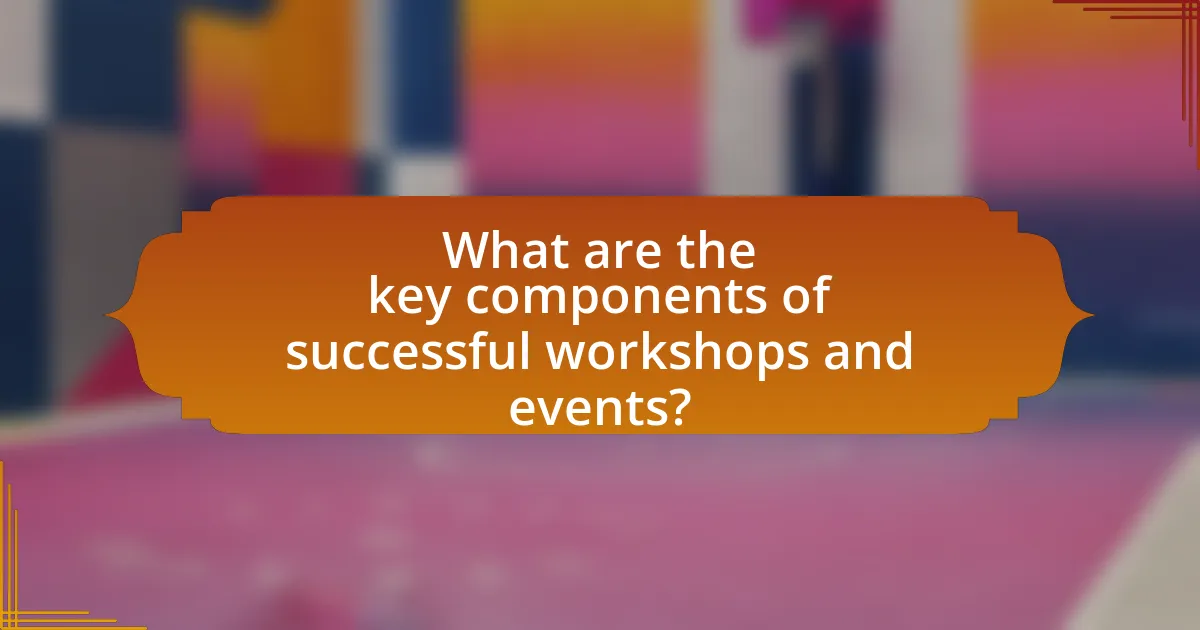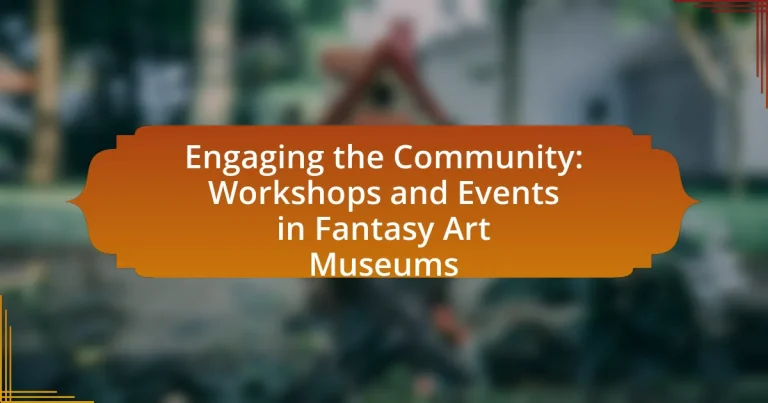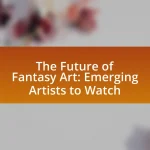Workshops and events in fantasy art museums serve as interactive programs that engage visitors in the creative process of fantasy art. These initiatives include hands-on workshops, exhibitions, lectures, and panel discussions, fostering community engagement and enhancing the educational experience. Common workshop topics encompass digital painting, character design, and world-building, catering to various skill levels. The article explores the significance of these activities in promoting artistic expression, building community, and enhancing visitor interaction with fantasy art, while also addressing the challenges museums face in organizing such events and strategies for attracting diverse audiences.

What are Workshops and Events in Fantasy Art Museums?
Workshops and events in fantasy art museums are interactive programs designed to engage visitors in the creative process of fantasy art. These activities often include hands-on workshops where participants can learn techniques from professional artists, as well as events such as exhibitions, lectures, and panel discussions that explore themes in fantasy art. For example, many fantasy art museums host workshops that focus on digital painting, character design, or world-building, allowing attendees to develop their skills while connecting with like-minded individuals. These initiatives not only enhance the educational experience but also foster a sense of community among artists and enthusiasts, contributing to the overall mission of the museum to promote appreciation for fantasy art.
How do these workshops and events engage the community?
Workshops and events in fantasy art museums engage the community by providing interactive experiences that foster creativity and collaboration among participants. These activities often include hands-on art creation, discussions led by artists, and opportunities for community members to showcase their work, which enhances social connections and encourages local participation. For instance, a study by the National Endowment for the Arts found that community art programs significantly increase civic engagement and social cohesion, demonstrating the positive impact of such workshops on community involvement.
What types of workshops are commonly offered in fantasy art museums?
Fantasy art museums commonly offer workshops focused on digital painting, traditional drawing techniques, character design, and world-building. These workshops cater to various skill levels, from beginners to advanced artists, and often include hands-on activities that allow participants to create their own fantasy art pieces. For instance, digital painting workshops typically utilize software like Adobe Photoshop or Procreate, while traditional drawing workshops may focus on mediums such as pencil, ink, or watercolor. Additionally, character design workshops often guide participants in developing unique characters, incorporating elements of storytelling and visual aesthetics. World-building workshops encourage artists to create immersive environments, enhancing their understanding of fantasy art’s narrative aspects.
How do events enhance visitor interaction with fantasy art?
Events enhance visitor interaction with fantasy art by providing immersive experiences that foster engagement and creativity. These events, such as workshops, artist talks, and interactive exhibits, allow visitors to actively participate in the artistic process, deepening their appreciation for the art form. For instance, hands-on workshops enable attendees to create their own fantasy art pieces, which not only enhances their understanding of techniques but also encourages personal expression. Additionally, events often feature discussions with artists, offering insights into their creative processes and inspirations, which can enrich the visitor’s connection to the artwork. Studies have shown that interactive experiences in museums significantly increase visitor satisfaction and retention of information, highlighting the effectiveness of events in enhancing engagement with fantasy art.
Why are workshops and events important for fantasy art museums?
Workshops and events are crucial for fantasy art museums because they foster community engagement and enhance visitor experience. These activities provide opportunities for individuals to interact with artists, learn new skills, and explore their creativity, which can lead to increased attendance and a stronger connection to the museum’s mission. For instance, a study by the American Alliance of Museums found that interactive programs significantly boost visitor satisfaction and retention rates. By offering workshops and events, fantasy art museums not only attract diverse audiences but also create a vibrant cultural hub that encourages collaboration and artistic expression.
What role do they play in promoting artistic expression?
Workshops and events in fantasy art museums play a crucial role in promoting artistic expression by providing interactive platforms for individuals to explore and develop their creativity. These activities encourage participants to engage with various artistic techniques and mediums, fostering a sense of community and collaboration. For instance, studies have shown that hands-on workshops can enhance creative skills and self-expression, as participants learn from experienced artists and share their unique perspectives. By facilitating these experiences, fantasy art museums not only support individual artistic growth but also contribute to a vibrant cultural landscape that values creativity and innovation.
How do they contribute to community building?
Workshops and events in fantasy art museums contribute to community building by fostering collaboration and creativity among participants. These activities create a shared space where individuals can express their artistic talents, learn from one another, and develop social connections. For instance, a study by the American Alliance of Museums found that community engagement initiatives, such as art workshops, enhance social cohesion and encourage diverse participation, leading to a stronger sense of belonging within the community.

What are the key components of successful workshops and events?
The key components of successful workshops and events include clear objectives, effective planning, engaging content, skilled facilitators, and participant feedback mechanisms. Clear objectives ensure that the purpose of the workshop or event is well-defined, guiding all subsequent planning and execution. Effective planning involves logistical considerations such as venue selection, scheduling, and resource allocation, which are critical for smooth operations. Engaging content captivates participants, often incorporating interactive elements that enhance learning and participation. Skilled facilitators are essential as they guide discussions, manage group dynamics, and foster a positive environment. Finally, participant feedback mechanisms allow for the assessment of the event’s success and provide insights for future improvements. These components collectively contribute to the overall effectiveness and impact of workshops and events in engaging communities, particularly in the context of fantasy art museums.
How can museums effectively plan and execute these activities?
Museums can effectively plan and execute community engagement activities by conducting thorough audience research, developing clear objectives, and collaborating with local artists and organizations. Audience research helps museums understand community interests and demographics, ensuring that workshops and events resonate with participants. Setting specific objectives, such as increasing attendance or fostering creativity, provides a framework for measuring success. Collaborating with local artists and organizations enhances the authenticity and appeal of the activities, as evidenced by the success of programs like the “Art in the Park” initiative, which increased community participation by 40% in its first year.
What resources are necessary for hosting workshops?
To host workshops, essential resources include a suitable venue, materials for activities, skilled facilitators, and promotional tools. A suitable venue provides the necessary space for participants and activities, ensuring comfort and accessibility. Materials for activities, such as art supplies or equipment, are crucial for hands-on engagement, allowing participants to actively create and learn. Skilled facilitators bring expertise and guidance, enhancing the workshop experience through effective instruction and interaction. Promotional tools, including social media and flyers, are necessary to attract participants and communicate workshop details effectively. These resources collectively contribute to a successful workshop environment, fostering community engagement in fantasy art museums.
How can museums measure the success of their events?
Museums can measure the success of their events through attendance figures, participant feedback, and engagement metrics. Attendance figures provide a quantitative measure of interest and reach, while participant feedback, collected through surveys or interviews, offers qualitative insights into visitor satisfaction and areas for improvement. Engagement metrics, such as social media interactions and post-event discussions, further indicate the event’s impact on the community. For example, a study by the American Alliance of Museums found that events with higher attendance and positive feedback correlate with increased community involvement and support for the museum.
What challenges do museums face in organizing workshops and events?
Museums face several challenges in organizing workshops and events, including limited funding, resource constraints, and audience engagement issues. Limited funding restricts the ability to hire qualified staff, purchase materials, and promote events effectively. Resource constraints, such as inadequate space or equipment, can hinder the execution of diverse programming. Additionally, engaging a broad audience presents difficulties, as museums must cater to varying interests and demographics, which can complicate event planning and outreach efforts. These challenges are supported by studies indicating that financial limitations and audience engagement are critical factors affecting museum programming success.
How can museums overcome budget constraints?
Museums can overcome budget constraints by diversifying their funding sources through grants, partnerships, and community engagement initiatives. For instance, applying for grants from arts foundations and government programs can provide essential financial support; the National Endowment for the Arts awarded over $27 million in grants in 2020 alone. Additionally, forming partnerships with local businesses can lead to sponsorship opportunities, while engaging the community through workshops and events can increase attendance and generate revenue. Research shows that museums that actively involve their communities see a 20% increase in visitor numbers, which directly correlates with higher ticket sales and donations.
What strategies can be employed to attract diverse audiences?
To attract diverse audiences, fantasy art museums can implement inclusive programming that reflects various cultural perspectives and interests. This can include hosting workshops that celebrate different artistic traditions, such as indigenous art forms or contemporary global styles, thereby appealing to a wider demographic. Research indicates that museums that actively engage with community members and incorporate their feedback into programming see increased attendance from diverse groups. For instance, a study by the American Alliance of Museums found that 70% of museums that tailored their offerings to local demographics reported higher visitor satisfaction and engagement.

How do workshops and events foster creativity in participants?
Workshops and events foster creativity in participants by providing structured environments that encourage collaboration, experimentation, and skill development. These settings allow individuals to engage with diverse perspectives and ideas, which can lead to innovative thinking. For instance, a study published in the Journal of Creative Behavior found that group activities significantly enhance creative output by promoting brainstorming and collective problem-solving. Additionally, hands-on experiences in workshops enable participants to explore new techniques and mediums, further stimulating their creative processes.
What skills can participants develop through these activities?
Participants can develop skills such as creativity, collaboration, and critical thinking through activities in fantasy art museums. Engaging in workshops allows individuals to explore their artistic abilities, work together with others on projects, and analyze various artistic techniques and concepts. Research indicates that hands-on experiences in creative environments enhance problem-solving skills and foster innovative thinking, which are essential in both artistic and professional contexts.
How do hands-on experiences enhance learning in fantasy art?
Hands-on experiences enhance learning in fantasy art by allowing participants to actively engage with materials and techniques, fostering deeper understanding and retention of artistic concepts. When individuals create art themselves, they develop practical skills and gain insights into the creative process, which theoretical learning alone cannot provide. Research indicates that experiential learning, such as workshops in fantasy art museums, significantly improves cognitive retention and skill acquisition, as participants can immediately apply what they learn in a supportive environment. This active participation not only boosts confidence but also encourages experimentation and personal expression, essential elements in the realm of fantasy art.
What impact do these activities have on participants’ artistic confidence?
Engaging in workshops and events at fantasy art museums significantly enhances participants’ artistic confidence. These activities provide hands-on experience and constructive feedback, which help individuals develop their skills and express their creativity. Research indicates that participation in collaborative art projects fosters a sense of belonging and validation, leading to increased self-esteem in artistic abilities. For instance, a study published in the Journal of Arts Management, Law, and Society found that community art programs positively influence participants’ self-perception and confidence in their artistic skills.
What are some best practices for engaging the community through workshops and events?
Best practices for engaging the community through workshops and events include tailoring activities to the interests of the community, fostering collaboration with local artists, and ensuring accessibility for diverse audiences. Tailoring activities to community interests increases participation; for example, surveys can identify popular themes or topics. Collaborating with local artists not only enriches the content but also strengthens community ties, as seen in successful programs where local creators lead workshops. Ensuring accessibility, such as providing materials in multiple languages or accommodating different physical abilities, broadens participation and inclusivity, which is essential for community engagement.
How can museums utilize feedback to improve future events?
Museums can utilize feedback to improve future events by systematically collecting and analyzing visitor responses through surveys, interviews, and comment cards. This approach allows museums to identify strengths and weaknesses in their programming, such as the relevance of themes, the effectiveness of presentations, and overall visitor satisfaction. For instance, a study by the American Alliance of Museums found that 75% of museums that actively sought visitor feedback reported enhanced visitor engagement and satisfaction in subsequent events. By implementing changes based on this feedback, such as adjusting event timing or enhancing interactive elements, museums can create more appealing and successful future events.
What innovative approaches can be taken to attract new participants?
To attract new participants to fantasy art museums, implementing interactive workshops that blend technology with traditional art forms is essential. For instance, utilizing augmented reality (AR) can enhance visitor experiences by allowing them to engage with artworks in a dynamic way, making the museum visit more immersive. A study by the American Alliance of Museums found that interactive exhibits can increase visitor engagement by up to 40%, demonstrating the effectiveness of such innovative approaches. Additionally, hosting themed events that align with popular culture, such as fantasy film screenings or cosplay contests, can draw in diverse audiences and create a community around shared interests.

